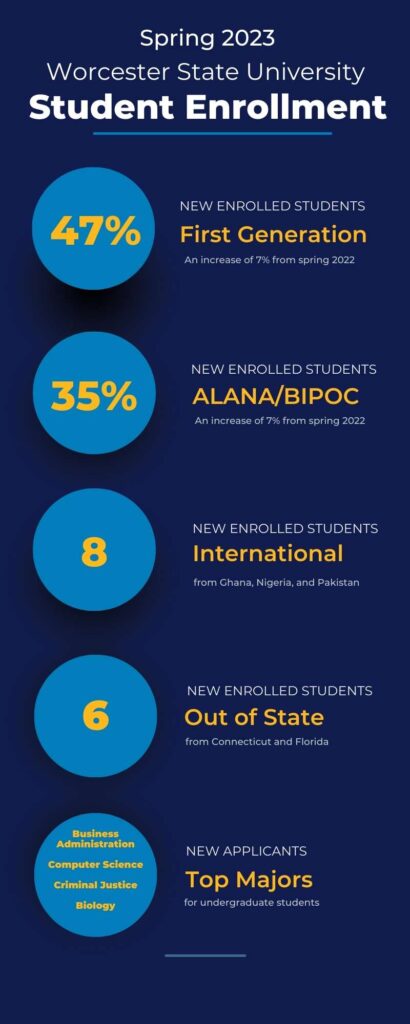A slow but steady rebound in overall student enrollment is continuing into the new year with spring 2023 enrollment increasing slightly over the same time last year, according to the latest university data.
At the end of January 2023, the university’s overall enrollment was 5,209 undergraduates and graduates, up 4.2 percent from spring 2022’s enrollment of 5,000 in January 2022. Within that, there are 4,395 undergraduates enrolled for spring and 814 graduate students enrolled—both slightly higher than 2022, with graduate numbers expected to increase through March. The increase in undergraduate enrollment is made up largely of non-degree seeking students participating in dual enrollment and early college programs.
While current enrollment is still below the university’s target of 6,500 students by 2027, the university is making progress after the pandemic’s profound disruption, says Vice President for Enrollment Management Ryan Forsythe, who shared the latest data in a campus enrollment update on Feb. 1.
Most encouragingly, the persistence rate—the rate of first-year undergraduate students enrolled in the fall who returned for the spring—saw a small uptick, bringing it closer to pre-pandemic levels.
“It is clear that two years later, the university is still rebounding from the impacts of the COVID-19 pandemic in terms of enrollment,” said Forsythe. “In general, we are trending in the right direction, and our focus on supporting students to persist toward graduation is making a difference.”
Undergraduate enrollment trends
After many years of stable student enrollment—about 6,200 students—the university experienced its first significant decline in more than a decade in fall 2020, Forsythe said. “That was precipitated by changes in the number of high school students and exacerbated by choices people made during the pandemic,” he said. “That decrease wasn’t just limited to fall 2020. It continued in 2021. And those decreases in enrollment were not exclusively limited to the students coming to us for the first time. We saw a decrease in the number of students persisting from one semester to the next.”
State education officials have been tracking a steady declin [1]e in Massachusetts high school students enrolling in college—a trend that is mirrored across the nation. Of particular concern for the state are widening disparities in college enrollment across gender, race, and ethnicity.
Nationally, universities have responded in a variety of ways—from new tuition schemes to a re-examination of admissions criteria. At Worcester State University, the focus has been on removing barriers to application, adopting policies that increase equity across student demographics, and improving application process efficiency. For spring 2023, Worcester State’s overall undergraduate applications were up 11.4 percent, and the university acceptance rate shrank by about 6 percent to an undergraduate acceptance rate of 58.4 percent.
Overall, however, the university’s acceptance rate over the last few years has increased from 67 percent to 78 percent, Forysthe said. “That means the students applying to Worcester State are becoming more and more eligible for admission,” Forsythe said. “It’s not because we changed our criteria or because of a lowering of standards.”
In 2018, Worcester State was among a number of state universities that moved to make SAT and ACT test scores optional as part of a Massachusetts Department of Higher Education pilot project. Educators and researchers have long pointed to racial biases in standardized testing. At WSU, an analysis was conducted prior to 2018 that demonstrated that previously accepted students’ SAT scores did not correlate with success at WSU. In fall 2023, more than 1,700 institutions around the country were test-optional and another 80-plus have dropped standardized test requirements completely, according to the National Center for Fair and Open Testing [2].
“Our internal data identified a significant number of applicants who were previously being denied admission based solely on a standardized test score,” said Joseph DiCarlo, dean of enrollment and director of admissions. “The waiving of test scores has also lessened barriers for students applying for admission, and thus has increased the number of qualified applicants being admitted to the university.”
With the removal of standardized test requirements, high school GPA and overall academic performance weigh most heavily in Worcester State’s academic criteria. Overall, the average high school GPA for new students has increased from 3.330 in fall 2017 to 3.479 in fall 2022—the highest in the last five years.
Over the past five years, the admissions team has been working to increase the pool of potential applicants to Worcester State and to improve application processing efficiency. This spring was the first semester when both first-year and transfer students could apply using the Common Application, an application program that allows students to apply to more than 1,000 universities nationwide.
The university saw a 64 percent rise in first-year applicants for spring 2023. Overall transfer student applicants were down 2 percent, while transfer student enrollment from Quinsigamond Community College increased 36 percent this spring.
The adoption of Admissions customer relationship management (CRM) software has increased the number of applications that can be reviewed and considered for admission, DiCarlo said, resulting in more acceptances.
“Efficiencies in our processes have also allowed us to shorten the time between when a student submits a completed application and when an admission decision is made,” he said. “This has resulted in more acceptances being made earlier in the admissions cycle.”
Editor’s note: This story is the first in a spring 2023 series focused on how the university is responding to changing enrollment trends and how the university is supporting student success. Look for future stories on new grant-supported retention initiatives, the university’s new enrollment management plans, and other trends in student enrollment.